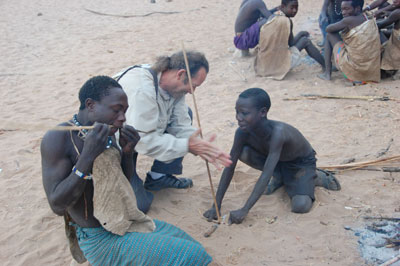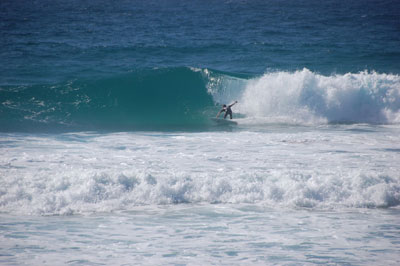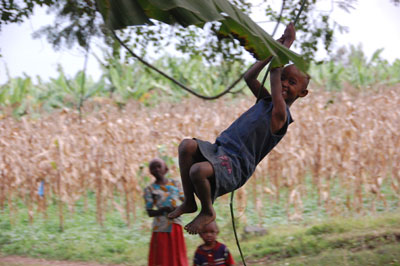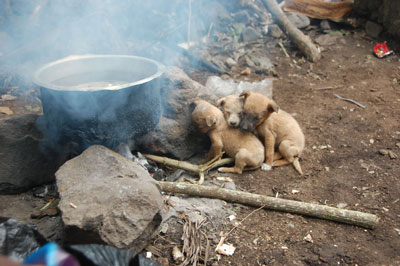Stepping into the past on an independent journey to East Africa
by Jim Sill, Silverado, CA
My self-guided, 7-week summer journey to East Africa was a search for my origins. Since we each are the result of our personal and collective experiences, on this trip I wanted to live life as it is now and as it might have been 10,000 years ago on the continent where Homo sapiens originated.
My itinerary included places and activities that would uniquely weave the past into the present. There was Tofo, a ’60s time warp in southern Mozambique where I could surf, meet other surfers and enjoy uncrowded beaches; Tanzania’s National Museum in Dar es Salaam, which houses the remnants of some of our most distant ancestors; Lake Eyasi, inhabited by one of the last hunter-gatherer peoples left on Earth, and Gombe Stream National Park, home to seven different species of primates, including troops of chimpanzees. I also planned to stay with a rural African family to get a feel for how so many people live today.
Getting there
I booked my round-trip flight to Johannesburg, departing Los Angeles on July 7, 2008, through Goway.com (800/387-8850). Goway’s staff was very helpful, and the fare was competitively priced.
I arrived on July 8, and my goal was to get out of Jo’burg as quickly as I could since it is one of the most dangerous cities anywhere. I checked into the centrally located Johannesburger, where a security guy rummaged through my rucksack on the way in (“We don’t allow guns”) and on the way out (“We want to make sure your room still has a TV”).
I caught a koombie (minibus) the next day to Mbabane, Swaziland — the smallest country in the Southern Hemisphere — staying just long enough to get a visa at the Mozambique embassy, located a short walk up the M3 highway, where I was provided with efficient, relatively inexpensive same-day service.
Mozambique
After a short bus ride, I found myself in Maputo, Mozambique’s capital. I checked my bearings. To see the National Museum of Art on Ho Chi Minh Avenue, I needed to walk up Karl Marx Avenue. The closest bank was on Mao Tse Tung Avenue. Closest police station? Kim Il Sung Avenue. Or I could just chill on a bench in Robert Mugabe Plaza.
The colorful street names — as well as undiscovered land mines — are left over from the country’s struggle against colonialism and their long civil war and represent Mozambique’s difficult recent past. Maputo does have a bit of an edge, reminiscent of Havana, but it has a lot of character. It’s well worth exploring.
Downtown Maputo is typical of many big cities in Africa, with people sitting on the sidewalks hawking everything from a few small onions to plastic flip-flops. I saw a shoeshine guy who had no shoes, but he was better off than the one-legged man nearby, who had nothing to offer except pathos.
But somehow they make do. Everyone seems to find a way to survive.
Paradoxically, this setting frames world-class arts and crafts, some of the best I’ve seen, occupying nearly every street corner.
Maputo also offers a unique dining experience in its Mercado do Peixe (fish market), located just off Avenue Marginal. You pick the fish or shellfish while it’s still wiggling (be prepared to haggle) and carry it over to one of the many nearby restaurants surrounding a large, tree-canopied courtyard where they grill it and add sides. On Sundays, whole families come to wile away the afternoon listening to Portuguese music.
I spent most of my Mozambique time in a village called Tofo, where one can swim with whale sharks during the warmer months (November through April) or surf a pretty nice point break at nearby Tofino, just a short walk away from Tofo’s premier surf resort, Turtle Cove, owned and operated by an affable South African expat named Nick. Quality surfboards and scuba equipment are available for rent in town.
Early on the morning I arrived in Tofo, as the sharp, tangy fragrance of wood and charcoal cooking fires scented the morning sea breeze, I surfed 8-foot waves that pitched forward in gnarly sections, with just five people in the lineup. I even drew a few locals who came to watch. Fortunately, nobody was looking when I cracked my ribs a few days later jumping into a Zodiac dive boat.
Tanzania
On arriving in Dar es Salaam, I checked into the Luther House Hostel on Sokoine Drive ($30-$40 per night, including breakfast), near the harbor and just a short walk from the National Museum.
Tanzania’s National Museum houses a skull of what was originally called Zinjanthropus boisei (later, Australopithecus bosei), also known as Nutcracker Man because of his massive lower jaw. But he was not a man, nor does his skull resemble that of an ape. He was a pre-Homo sapiens hominid who roamed the Rift Valley on two legs about 1.75 million years ago.
Locally excavated fossils and tools of these creatures, as well as the fossils and tools of Homo erectus and early Homo sapiens, attest to Africa’s being the cradle of mankind.
After a couple of days in Dar, I caught a flight to Arusha, Tanzania’s north-central activity hub. Arusha feels a little like that intergalactic bar in Star Wars, with colorfully robed Maasai men hanging out, men and women in sarongs and a pretty eclectic assortment of others. The only other place I’ve seen that even comes close is Hollywood Boulevard.
Beyond city life
My first destination was the Tanzania Tourist Board on Boma Road, where I was introduced to a safari outfit named Crown Eagle Adventure (phone +255 754 263085, www.crown-eagle.com). I negotiated a safari for five days in Serengeti, Manyara, Tarangire and Ngorongoro Crater national parks for $750, all inclusive. Two more days with the area’s hunter-gatherer people cost an additional $630 because I would have the exclusive use of a 4WD vehicle with a driver-guide plus a cook — all inclusive except for a local guide.
Afterward, I walked a short distance to the Precision Air (www.precisionairtz.com) office to book my flight to Kigoma ($350 round trip), which I would take upon my return from safari.
Kigoma, in western Tanzania, is the jumping-off place for Gombe Stream National Park on the northern shore of Lake Tanganyika. At 52 square kilometers, Gombe Stream is Tanzania’s smallest park, but in terms of viewable primates it is one of its biggest. It is the place where Jane Goodall conducted a 15-year study of chimpanzees, animals that carry more than 98% of our genetic code.
The animal part of my safari was spectacular. We saw the Big Five plus a lot of other critters up close.
The two different hunter-gatherer clans I spent time with allowed me to hunt and gather with them in addition to just hanging out with them in their encampments. Their knowledge of their environment is incredibly detailed. Although they and their children never see doctors, they know which plants have medicinal qualities, which ones to eat and which ones to avoid.
Before I left, one man took me to a nondescript tree, cut it with a knife and smeared a little sap on my wrist. This, he explained through my interpreter, was local skin protectant. I smelled the glaze on my wrist. It was one of the sweetest, most exotic scents I have ever smelled, and it lasted all day until I washed it off that evening.
Unfortunately, I could clearly discern that the culture of these clans was dying out due to habitat encroachment, intermarriage, cultural contamination and the hard life they lead.
Upon arriving in Kigoma, I checked into the Mapinduzi Guest House ($8 per night with cable TV), located on Lumumba Avenue, the town’s main drag. The next morning I boarded a boat to go the 15 or so kilometers across Lake Tanganyika to Gombe Stream National Park. A short time later I saw my first chimp, high in a tree munching leaves.
We walked farther into the park. Suddenly coming up the trail in front of us was a troop of about 12 chimps, casually ambling toward us. I started to climb the hillside, but my guide, Emilion, told me to sit down just above the trail. I did. One by one they walked by, so close I could have reached out and touched them.
The trip to Gombe was worth the effort. Of the seven primate species that occupy this little gem of a park, I saw five, including many more chimps.
In the shadow of Mt. Meru
After the flight back to Arusha, I visited the tourist information center again, asking them about booking a cultural tour and a stay with a local family. They put me in touch with a man named John Henry Ngowi, who invited me to stay with his family in a rural area just outside Arusha National Park in a village named Ngurdoto.
I negotiated a rate of TS200,000 ($160), which included the use of a sleeping bag and pup tent plus guide services, bottled water, food and most transportation.
We took a dala dala (minibus) about 30 kilometers south of Arusha, then walked several kilometers through swampy forest until we reached John’s home. It was situated on about an acre of land planted mostly in banana trees, corn and coffee. The home had three small bedrooms, with worn tapestry serving as the doors to each one, and a dirt floor. Chickens wandered in and out.
John set up a pup tent for me outside the house, near where the goats were kept. Then he introduced me to his wife and children and to Emanuel, who would take me for walks around the area.
My first trek with Emanuel was through some swamps, then up a hill where I was assured we would have good views of nearby Mt. Meru and Kilimanjaro. The steep ascent took about two hours and it kicked my butt.
When we reached the top, both mountains were shrouded in clouds, but joyous serendipity — as only Africa can provide — greeted us. A full-blown revival meeting was going on in a large tent, with animated believers, arms flailing, singing African gospel.
We went to a clearing a short distance from the tent and listened. A lead singer would sing a melody, followed by a beautifully harmonious chorus. It was almost hypnotic as it repeated over and over.
“They come up here to be closer to God,” said Emanuel.
That night, I tried to relive the melodies I had heard up on the mount, but the bleating, clucking, braying and bellowing of all the farm animals around me overwhelmed the vocal sweetness in my memory.
The next day, while we had tea and bread for breakfast, I noticed that everyone seemed to be in kind of a bad mood. The puppies snapped at each other and got in a big fight with some chickens over a few scraps of coconut. The dogs snapped at the puppies and each other. John’s wife managed to smile at me, but I could see she was already worn out from all her morning chores.
Both she and John were bone skinny. The farm animals were also on the thin side and seemed ill tempered.
By the third day, I realized why: life there was hard. They had no electricity to refrigerate food or to run pumps to irrigate their fields. That explained the relatively meager crops on everyone’s land. Everyone had bad, orange teeth because their water supply was mineral heavy. John showed me a pond fed by an underground stream where the villagers obtained water that was carried back to each home in gas cans. The rocks surrounding the pond were coated with a white, snow-like crystal.
Although I was supposed to stay longer, I decided to go back to Arusha that afternoon, not because I couldn’t handle the conditions in which I was living but because I couldn’t handle the way the people of Ngurdoto had to live.
Epilogue
When I first set out on this journey, I wanted a historical perspective in which to frame the present. My flirtations with the past, and my experiences on this trip, gave me pause to consider the future.
We are at a historic crossroads. A few thousand years ago when only a few million of us shared this planet, humankind’s impact on Earth and each other was relatively minimal. Today, there are more than 6.5 billion of us. Naturally enough, many people in the developing world want the same things that people in the industrialized world already have. At the same time, the resources and habitat from which those things are derived are diminishing.
I now realize that “localization” should be integral with globalization. By “localization,” I refer to generating food, potable water and energy on a local basis, from the smallest rural village in Africa to the suburbs surrounding New York City.
I would ask those of us in the ITN community to reduce the size of our footprints so there is room for other people to make theirs. As travelers, we can set an example by reusing our water bottles and carrying our own bags for purchases made along the way in order to reduce the scourge of plastic trash that litters our streets, fouls our oceans and fills our dumps.
We can volunteer in areas where people need help. Simple business skills or mastery of English are huge gifts to the many people who lack even the most basic skills.
What we do now matters more than ever before.






